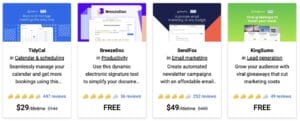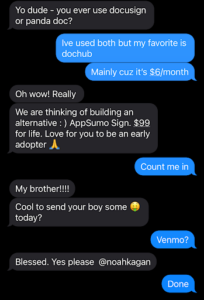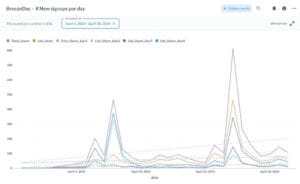Our newest product BreezeDoc did $60,093+ in 40 days.
It’s our 4th product in the last 3 years on track to generate $1m in revenue in ~12 months.
Last week, I sat down with David Kelly, the General Manager for AppSumo Originals to share exactly how we ideate, build, test, and launch products.

The goal of AppSumo Originals products (TidyCal, KingSumo, SendFox) is to introduce people into the AppSumo ecosystem
1) Use Prioritization Checklists
Many founders and leaders are familiar with the RICE prioritization framework (Reach, Impact, Confidence, and Effort).
At AppSumo Originals, we use a similar 4-step checklist:
1) Hyped AF – Are we hyped AF about this? “I’m always surprised and amazed by how many entrepreneurs build things they don’t really want,” David said. “But that’s a recipe for an unwanted and unused product.” Scratch your own itch!
2) New Buyers – does this serve the customers we want to attract? “We aren’t afraid to look at competitors,” David said candidly. “Competition means there is market availability and that we can approach it a bit differently.”
3) Ease of Creation – is this a relatively easy product to create? “AppSumo customers have begged for a Canva alternative,” David said. “But the complexity is way outside of our wheelhouse. We don’t want to spend years building in the dark.”
4) Word of Mouth – All three of our previous winners had virality baked into the product,” David said. “When people share their TidyCal link, send emails using SendFox, or share a document through BreezeDoc – it introduces the product to new potential customers.” GENIUS!!
“The main thing we’re focused on,” David said, “What’s the simplest way to achieve our goal of introducing people into the AppSumo ecosystem and serve our audience as quickly as possible?”

2) Velocity to The Dollar
The reason we’ve limited the number of failed startups at AppSumo is simple:
We validate the idea BEFORE we fully build it out.
What do I mean?
Before building BreezeDoc, we asked people in our Zone of Influence if they’d be interested in a DocuSign alternative. Even more importantly, we asked if they’d be interested in pre-buying.
You can see me validating BreezeDoc in this video!

There’s a big difference between what people say and what people do. Everyone is “interested” until they have to pay.
Once we see enough interest in the idea, THEN we start to build it out.
We started working on BreezeDoc at the end of January.
“We keep the team small on purpose to start,” David said. “Just me, Henrique (designer), and Garrett (developer) at first. Then we bring another awesome developer, Marnie, in as we’re building the backend. When the team is too large, we get too many opinions, which leads to inaction.”
3) Work WITH Customers
Our 30-day MVP process has 3 phases:
Phase 1: First Beta Version
The first thing we do is collect a lot of information on our customers. We TALK to them as much as possible (obviously using a TidyCal link 😉).
Next, we list the top basic features our product should do in its MVP stage.
“The goal is to cover the most bases, knowing that we can iterate in the later stages,” David said.
Within the first three weeks, we have our first beta version. Then we bring in team members to start building it — and start to beta test our MVP with customers to see their reaction.
Phase 2: Customer Feedback
For BreezeDoc, we did about 6 weeks of beta testing and iterating. This is longer than usual, but we wanted to make sure to get REALLY great feedback.
We talk to our customers AGAIN and get feedback:
- How’s it going? We reach out early (and often repeatedly) to get feedback
- What do you hate/what is broken?
- What’s missing?
Here’s an example of our “changelog” site that shows updates we’ve made based on user feedback:

Phase 3: Marketing Experiments
The goal for the first 30 days was to get 100 new customers. With that, we worked backward to put together a spreadsheet of marketing activities we could do (Steal our template here).
For BreezeDoc, we tried Meta ads, email, cold outreach, ProductHunt, etc.

To create your own marketing plan:
- Work backward from a clear goal
- List all the free marketing activities you could do
- Add predictions by guesstimating (Google around for metrics if you need)
- Track your ACTUAL results
- Do more of the activities that work, and iterate or come up with other ideas for the ones that don’t
By the end of the month, we had 189 new buyers. Success!!
4) Track Key Performance Indicators
One thing we’ve focused on is getting more granular with our tracking. Think about the KEY success metrics of your customers and break each of those down.
We look at several Key Performance Indicators (KPIs):
- # of new signups per day
- % new signups creating a document within 7 days of signup
- Total # of documents created per day
- Conversion rate % of free to paid customers

We use Metabse to track # of new signups per day
Then we do a weekly report of these metrics to see trends. They help us understand the quality of the product and whether people are actually using it.

The analogy David used is like being in the cockpit of an airplane. The metrics tell us if our altitude is too low or if our speed is high enough.
5) Do Less, But Better
So what are we doing next?
“I get asked that question a lot,” David said. “I don’t encourage early founders to look past a year. Our goal right now is to continue improving TidyCal and SendFox – and continue building out BreezeDoc.”
Instead of building more new things, we’re focused on improving the apps that people want.
Rooting for you,
Noah 🌮
Ps. Many of these strategies and frameworks are from my book Million Dollar Weekend. If you want to build your 7-figure business this weekend – check it out! 💚

Leave a Reply